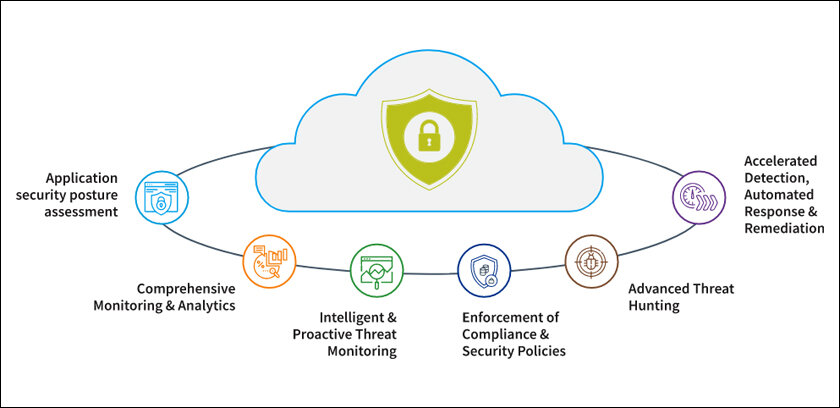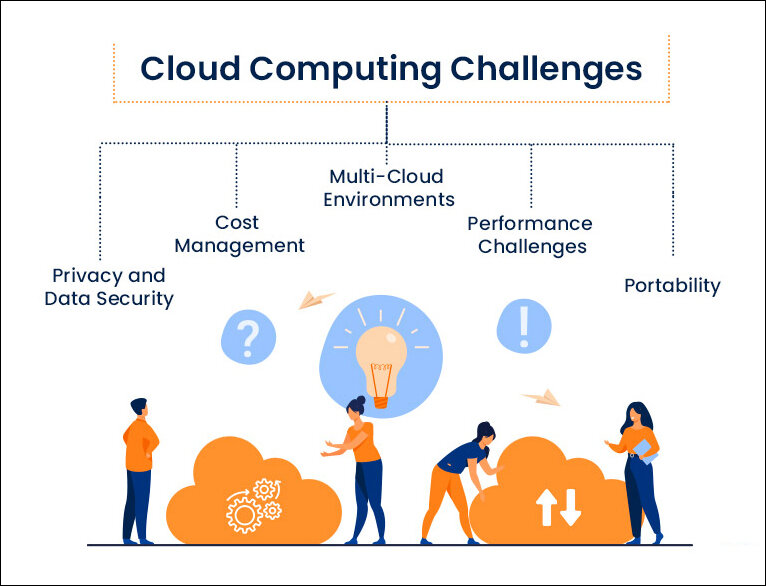The future of cloud computing is a fine balance between the flexibility of the cloud and the protection of data, where hybrid and multi-cloud form the music of continued innovation.
Consider running an internet discussion with thousands of users – while it requires immense stability and protection, it also needs to be able to adapt to the increasing number of users in a matter of seconds. However, sudden surges in the number of attendees during live sessions place great stress on their on-premises servers, to the point that the courses become frustrating to manage. That’s the cloud conundrum for business today.
This is where hybrid and multi-cloud technologies provide the prerequisite solution. To effectively address the demands of large audiences, the organisation uses a public cloud for live streaming and chat during times of maximum attendance while preserving the confidentiality of data in a private cloud. Scalability and security go hand in hand with this strategy, making it a great combination for any global event.
Let’s now examine the most recent developments, challenges, and innovations influencing hybrid and multi-cloud solutions in 2024.

Some recent developments in Hybrid and Multi-Cloud Technologies
Enhanced Interoperability
One of the biggest changes that will be observed in hybrid and multi-cloud technologies by 2024 is better integration. Currently, cloud providers are working towards providing synchronous compatibility between different environments of clouds. For example, Microsoft Azure Arc helps organizations maintain and govern resources in on-premises, edge, and multi-cloud spaces. This makes it more efficient to run the cloud services and it gets rid of the hassle of dealing with different cloud services. A real-time example is Nokia, which is a multinational firm that applies Azure Arc to govern the firm’s IT resources irrespective of their location, as well as ensure the smooth functioning of the IT systems.
Advanced Security Measures
As organisations transition to hybrid and multi-cloud systems, security continues to be a top priority. With improved encryption standards, AI security analysis, and the zero-trust architecture, cloud security in 2024 will be even more strengthened. Such solutions as IBM Cloud Pak for Security are instrumental in this by presenting companies such as IBM with extensive security analytics across hybrid and multi-cloud settings. For example, the world’s largest bank, BNP Paribas, uses IBM’s tight security to protect its financial data and adheres to stringent legislation in multiple clouds.
Integration of AI and Machine Learning
AI & ML are now embedded in hybrid and multi-cloud environments in today’s world. These technologies enable predictive algorithms, control of resources, and improvement of organizational processes. For example, the Google Cloud AI Platform offers solutions that cover the entire machine learning development process and deployment across different clouds. This capability enables the formulation of crucial conclusions and the application of automation across an organization.
One of the best use cases of AI and ML cooperation can be discussed concerning GE Healthcare, where Google Cloud AI and ML are implemented in the company’s medical imaging products. Using these technologies, GE Healthcare has enhanced imaging algorithms that aid radiologists in better and faster diagnosis of a condition. This integration benefits the patient by improving their health while at the same time enhancing the efficiency of operations in healthcare institutions, thus highlighting the effectiveness of AI & ML in hybrid and multi-cloud models.
The Challenges of Hybrid and Multi-Cloud Environments
Indeed, hybrid and multi-cloud are a perfect solution for businesses, although orientation in such a topology is not easy. Here are the key challenges that organisations need to address effectively:

The Complexity of Management:
It can be challenging when an organization is using multiple cloud environments that have different tools interfaces and billing structures. The IT teams require skills in managing the different cloud management platforms, security solutions, and orchestration services for a seamless functioning across the hybrid and multi-cloud ecosystem. For instance, a company may use AWS to host resources, Microsoft Azure to host data, and a private cloud especially for storing financial information. While working with different platforms, it is revealed that each has a unique management console and billing system, and IT personnel need to be acquainted comprehensively with these interfaces for handling the inventory, solving problems, and controlling expenses.
Security Concerns:
The ability to maintain uniform security across several cloud domains is one of the fundamental challenges. Therefore, for all types of clouds, businesses must create and put into place strict security procedures that include encryption, access rights, risk assessment, and compliance with legal requirements. This is especially true when working with a multi-cloud environment, where data can be located on different providers’ platforms with various levels of protection. For instance, a healthcare provider may allow patient records to be stored on the private cloud due to privacy concerns but may use the public cloud for analytics. So, it is important to keep an equal level of encryption, access control, and periodic security checks in both settings to avoid compromising patient information and medical records.
Vendor Lock-In:
Still, vendor lock-in is a potential concern when it comes to multi-cloud. The rationale behind multi-cloud is to avoid being overly reliant on a single vendor, but even here this issue persists. This means that organizations can end up locked in with particular cloud providers for particular services or employments, and it can be inconceivable and costly to shift to another provider in the future. For example, an enterprise may rely on several computing applications that are not available on a server provided by a typical cloud provider. When they consider changing providers in the future, they may have a problem transferring their applications to another serverless provider because of proprietary functions or interfaces. The key to avoiding being locked into a particular cloud provider is to research and effectively determine which providers can offer the services needed now and in the future without requiring a change in providers.
Innovations Enabling Hybrid and Multicloud Adoption
Edge Computing
Hybrid and multi-cloud architectures are being enhanced by edge computing, as it offloads computation and storage closer to data origin. This innovation helps lower the latency and enhances the response time for applications that require real-time output. Tech giants like AWS are already providing solutions like AWS Outposts to bring the AWS infrastructure services into the customer’s premises. A clear example is in self-driving cars, where edge computing comes in handy to process data and make decisions in real time, which is vital to operations.
Kubernetes and Containerisation
Kubernetes and the use of containers are emerging as a new solution to deploy and manage applications in hybrid and multi-cloud environments. Kubernetes offers a foundation for automatically deploying, scaling, and managing application containers across the clusters of hosts. This technology is backed by prominent cloud providers such as Google Cloud Anthos that apply consistent management across the hybrid or multi-cloud setup. For example, the fintech firm PayPal deploys Kubernetes to guarantee the high availability and horizontal scalability of its services when deploying onto a variety of cloud platforms to support its global payment processing needs.

Serverless Computing
Serverless computing is a form of cloud computing in which the cloud provider manages the execution of all application code in response to events while providing limited computing resources for the code to run. This innovation makes the development process less complex and improves scalability among the applications. Azure Functions and AWS Lambda are examples of Serverless Computing that enables businesses to upload code which runs in response to particular events and these can automatically scale up or down. An example of this is Netflix, the video streaming company that utilizes AWS Lambda for managing content and delivery to viewers across the globe.
Key Takeaways
The future of cloud computing is a fine balance between the flexibility of the cloud and the protection of data, where hybrid and multi-cloud form the music of continued innovation. AI-based security solutions and serverless architecture, which are relatively new concepts, have opened the door to a new level of organizational efficiency and business scalability. But it’s not easy to simplify this complex system, which is why sophisticated IT players, the real choreographers are needed. Thereby, the limitations of a single cloud are history. The stage is set for businesses to unlock a new level of efficiency and scalability; the only question is, are you ready for your curtain call? For more detailed information on trends such as hybrid and multi-cloud, visit Sify Technologies and explore their comprehensive resources on cloud solutions.
In case you missed:
- Deciphering RHEL AI: An Open Source Approach to Artificial Intelligence
- Top 5 Cybersecurity Trends in 2024: Protect Your Business Now
- What’s new in Azure app service at Build 2024: Key announcements and features
- Kickstarting your MLOps journey in 2024: Essential practices and strategies
- Blackwell chip: Nvidia engine for breakthrough AI
- Unleashing the Power of Voice: Exploring Meta Voicebox AI
- Devin AI: Software Engineers’ Next-Gen Assistant
- Is this the Future of Mobile AI? Apple Introduces ReaLM
- Vulnerability Assessment vs Penetration Testing: Choosing the Right Strategy in 2024
- Alteryx’s New AI Assistant: Streamlining Analytical Workflows









